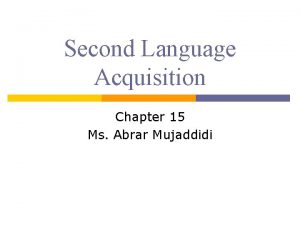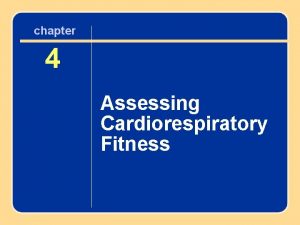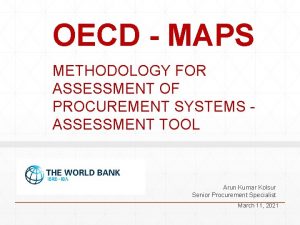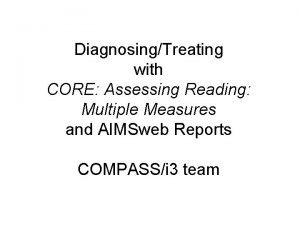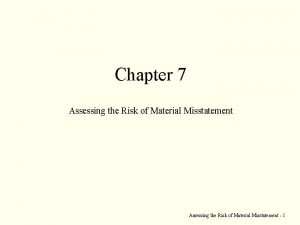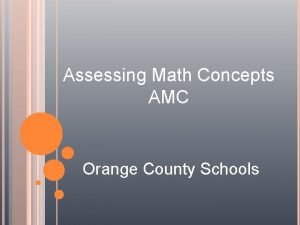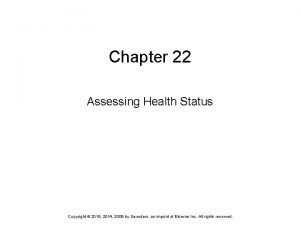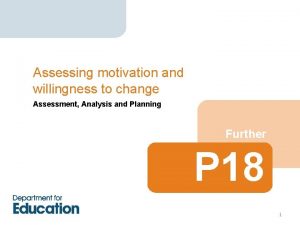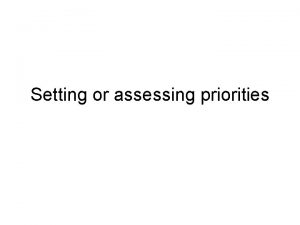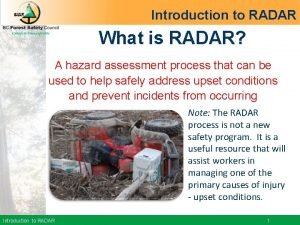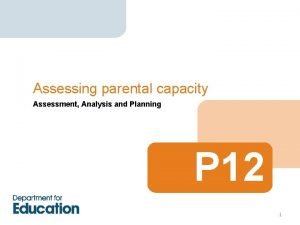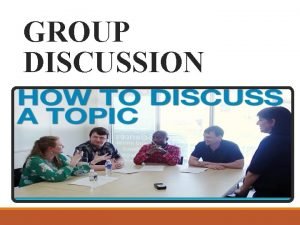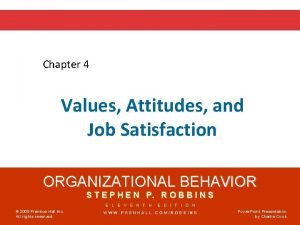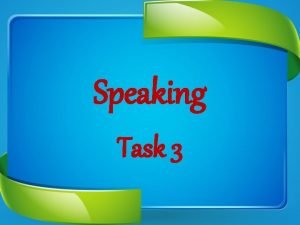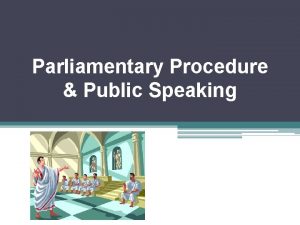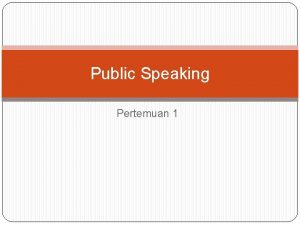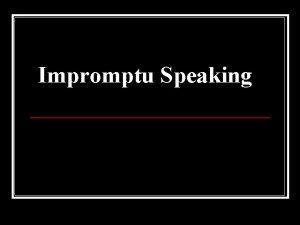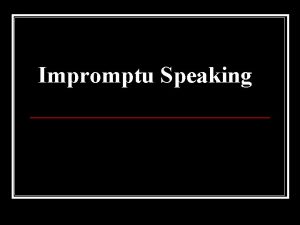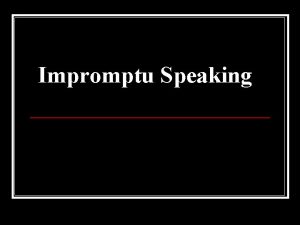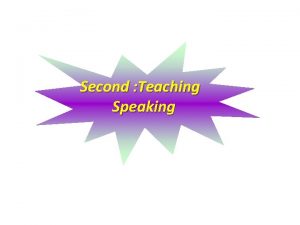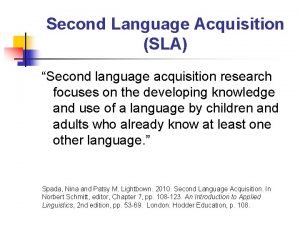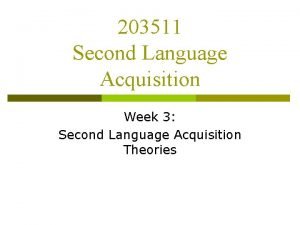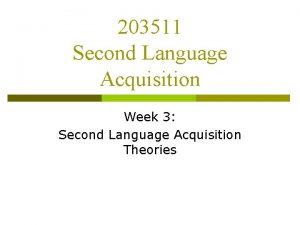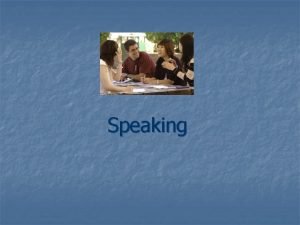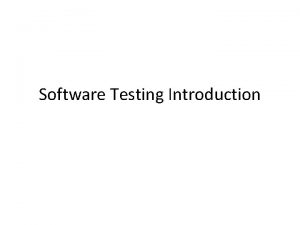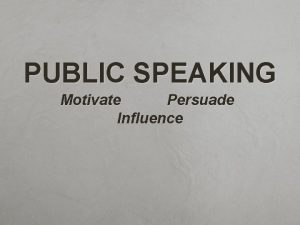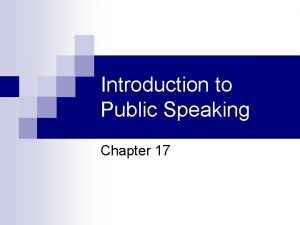ASSESSING SPEAKING Introduction The testing of second language
































- Slides: 32

ASSESSING SPEAKING

Introduction The testing of second language speaking is a relatively new field, even within the young discipline of applied linguistics. The aspects of speaking that are considered part of its assessment include grammar, pronunciation, fluency, content, organization, and vocabulary. (Kitao & Kitao, 1996). Depending on the situation and the purpose of the test, testers need to choose the appropriate methods and techniques of testing.

Relationship between Speaking and Listening speaking and listening skills are very much related to each other; it is difficult to separate them. In most cases, there is an interchange between listening and speaking, and speaking appropriately depends on comprehending spoken input. Therefore, this has an impact on testing speaking because the testers will not know whether they are testing purely speaking or speaking and listening together.

Basic Types of Speaking Imitative Extensive Basic Types of Speaking Interactive Intensive Responsive

Basic Types of Speaking • Imitative. It is simply the ability to parrot back a word or phrase or a sentence. • Intensive. It is the production of short stretches of oral language. Examples include directed response tasks, reading aloud, sentence and dialogue completion, limited picture-cued tasks.

Basic Types of Speaking • Responsive: The tasks include interaction and test comprehension but at the limited level of short conversations, standard greetings, small talk, requests, and comments. • Interactive: The length and complexity of the interaction are more in interactive tasks than in responsive ones. The task sometimes includes multiple exchanges and/or multiple participants.

Basic Types of Speaking • Extensive: (monologue) The tasks include speeches, oral presentations, and story-telling. Oral interaction from listeners is either highly limited or ruled out altogether.

Micro and Macro of Speaking The micro-skills refer to producing the smaller The macro-skills imply the speaker’s focus on the chunks of language such s phonemes, morphemes, words, collocations, and phrasal units. larger elements: fluency, discourse, function, style, cohesion, nonverbal communication, and strategic options.

Assessment Tasks: Imitative Speaking • Phonologically focused repetition tasks range from word level • • to sentence level usually with each item focusing on a specific phonological criterion. Word repetition task Test-takers hear: beat/bit bat/vat Sentence repetition task I bought a boat yesterday. The glow of the candle is growing. Test-takers repeat the stimulus.

Scoring Scale for Repetition Tasks • 2 • 1 • 0 acceptable pronunciation. comprehensible, partially correct. silence, seriously incorrect.

Phonepass Test • It elicits computer-assisted oral production over a telephone. Test-takers read aloud, repeat sentences, say words, and answer questions. • Part A: Test-takers read aloud selected sentences. • Examples: Traffic is a huge problem in Southern California.

• Part B: Test-takers repeat sentences dictated over the phone. • Example: Leave town on the next train. • Part C: Test-takers answer questions with a single word or a short phrase. • Example: Would you get water from a bottle or a newspaper? • Part D: Test-takers hear three word groups in random order and link them in a correctly ordered sentence. Example: was reading/my mother/a magazine.

• Part E: Test-takers have 30 seconds to talk about their opinion about some topic that is dictated over the phone. Topics center on family, preferences, and choices. • Scores are calculated by a computerized scoring template and reported back to the test-taker within minutes.

Assessment Tasks: Intensive Speaking • 1 - Directed Response Tasks • 2 - Read-Aloud Tasks • 3 - Sentence- Dialogue Completion Tasks and Oral Questionnaire • 4 - Picture- Cued Tasks • 5 - Translation

Directed Response Tasks • These type of limited response tasks are mechanical not communicative, but they require minimal processing of meaning in order to produce the correct grammatical output. Examples: • Tell me he went home. • Tell me that you like rock music. • Tell me that you aren’t interested in tennis. • Tell him to come to my office at noon. • Remind him what time it is.

Read-Aloud Tasks • • • Pronunciation: Points: 0. 0— 0. 4 frequent errors and unintelligible. 0. 5— 1. 4 occasionally unintelligible. 1. 5— 2. 4 some errors but intelligible. 2. 5— 3. 0 occasional errors but always intelligible.

Read-Aloud Tasks Fluency: Points: 0. 0– 0. 4 slow, hesitant, and unintelligible. 0. 5– 1. 4 non-native pauses and flow that interferes with intelligibility. • 1. 5 --2. 4 non-native pauses but the flow is intelligible. • • • 2. 5— 3. 0 smooth and effortless.

Variations of Read-Aloud Tasks • Reading a scripted dialogue. • Reading sentences containing minimal pairs. Examples: Try not to heat/ hit the pan too much. • Reading information from a table or chart.

Read-Aloud Tasks • Advantages: • Comparisons between students are quite simply. • Tests are easy to prepare and to administer. • Predictable output, practicality, and reliability in scoring.

Read-Aloud Tasks • Disadvantages: • It is inauthentic, except in situations such as parent reading to a child, sharing a story with someone, giving a scripted oral presentation. • It is not communicative in real contexts.

Sentence- Dialogue Completion Tasks and Oral Questionnaire • First, test-takers are given time to read through the dialogue to get its gist, then the tape/teacher produces one part orally and the test-taker responds. • Example (p. 150) short dialogue (p. 151)

Sentence- Dialogue Completion Tasks and Oral Questionnaire Advantages: Moderate control of the output of the test taker Disadvantages: 1. Reliance on literacy and an ability to transfer easily from written to spoken English. 2. Contrived, inauthentic nature of this task. The same objective might be better accomplished using a role- play technique. Or we can say that such completion tasks are nothing more than a set of written form of questions that is part of a standard oral interview.

Picture – Cued Tasks • Pictures may be very simple designed to elicit a word or a phrase or complex like storytelling or elicitation of minimal pairs. (like ship and sheep). Grammatical categories may be cued by pictures as well. Comparative forms are elicited by this type of oral language elicitation. Also future tense, negatives, numbers, prepositions and finally description of people is elicited through picture- cued tasks. • A picture-cued stimulus requires a description from the testtaker. It may elicit a word, a phrase, a story, or incident.

Scoring Responses on Picture- Cued Tasks Scoring responses on picture- cued intensive speaking tasks varies depending on the expected performance criteria. Some can be evaluated simply as “ correct” or “incorrect” and some others as three- point rubrics, and finally some others may be more complicated to be scored like opinions about paintings or directions on a map.

Translation • Translation is a communicative device in contexts where English is not a native lang. • English can be called on to be interpreted as a second language. • Conditions may vary from an instant translation of a native word, phrase, or sentence to a translation of longer texts. • Advantages: the control of the output & easily specified scoring.

Responsive Speaking • • 1 - Question and Answer Examples: 1. What is this called in English? ( to elicit a predetermined correct response) 2. What are the steps governments should take, if any, to stem the rate of deforestation in tropical countries? ( given more opportunity to produce meaningful language in response)

Responsive Speaking • • 2 - Questions Eliciting Open-Ended Responses 1. What do you think about the weather today? 2. Why did you choose your academic major? 3. a. Have you ever been to the U. S. before? b. What other countries have you visited? c. Why did you go there? What did you like best about it?

Giving Instructions and Directions • Examples: how to operate an appliance, how to put a bookshelf together, or how to create a dish. • Scoring: based on (1) comprehensibility (2) Specified grammatical/discourse categories.

Eliciting Instructions or Directions • • • Test-takers hear: Describe how to make a typical dish What’s a good recipe for making _____? How do you access email on a PC computer? How do I get from ___ to ____ in your city? Test-takers respond.

Eliciting Instructions or Directions • The task should require the test-taker to produce at least 5 or 6 sentences. • Use familiar topics and test linguistic competence. • Paraphrasing • Examples: paraphrasing a story and paraphrasing a phone message (p. 162)

Considerations for Paraphrasing • 1. elicit short stretches of output • 2. the criterion being assessed: a. Is it a listening task more than production? b. Does it test short-term memory rather than linguistic ability? c. How does the teacher determine scoring of responses?

Conclusion Speaking It assessment is very difficult. is important to determine what criteria to use to assess whether accuracy or fluency. Such criteria can be based upon created models or adapted ones.
 What is language acquisition
What is language acquisition Difference between second language and foreign language
Difference between second language and foreign language Difference of first language and second language
Difference of first language and second language Difference of first language and second language
Difference of first language and second language Introduction to language testing
Introduction to language testing 27 miles per gallon into kilometers per liter
27 miles per gallon into kilometers per liter Btec sport level 3 unit 3
Btec sport level 3 unit 3 Unit 18 assessing children's development support needs
Unit 18 assessing children's development support needs Assessing grammar effectively
Assessing grammar effectively Ppst philippine professional standards for teachers
Ppst philippine professional standards for teachers Assessing need for hrd
Assessing need for hrd What is formal assessment
What is formal assessment Manual for assessing safety hardware
Manual for assessing safety hardware Chapter 4 cultural dynamics in assessing global markets
Chapter 4 cultural dynamics in assessing global markets Assessing a new venture's financial strength and viability
Assessing a new venture's financial strength and viability Assessing cardiorespiratory fitness
Assessing cardiorespiratory fitness Assessing leadership and measuring its effects
Assessing leadership and measuring its effects Many new drivers first fender bender is a backing collision
Many new drivers first fender bender is a backing collision Module 4 topic 1 assessing and managing risk
Module 4 topic 1 assessing and managing risk A nine box matrix requires assessing employees on ________.
A nine box matrix requires assessing employees on ________. Oecd maps
Oecd maps Core graded high-frequency word survey
Core graded high-frequency word survey Acceptable audit risk
Acceptable audit risk Amc orange county
Amc orange county Chapter 22 assessing health status
Chapter 22 assessing health status Assessing motivation to change
Assessing motivation to change Assessing opportunity cost involves
Assessing opportunity cost involves Hazard communication quiz answers
Hazard communication quiz answers Cultural dynamics in assessing global markets
Cultural dynamics in assessing global markets Assessing value for money
Assessing value for money Assessing parental capacity
Assessing parental capacity Group discussion
Group discussion Values attitudes and job satisfaction
Values attitudes and job satisfaction

